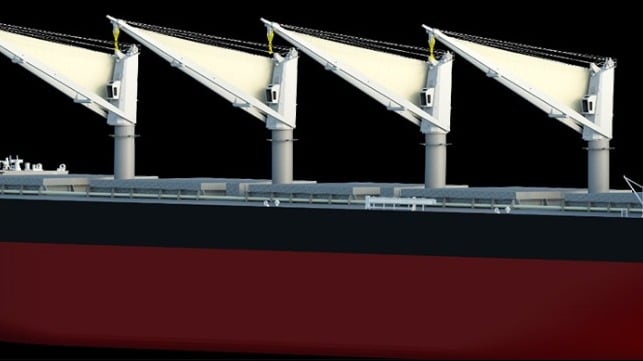Japanese Design Employs Sails on Cargo Ship Cranes

Japanese shipping company Mitsui O.S.K. Lines is continuing to explore methods of incorporating wind propulsion into its ships. The company has previously said that it believes wind propulsion would provide benefits and is well suited to its fleet of larger, slower moving dry bulk carriers.
In a new research and development project, Mitsui O.S.K. Lines and its MOL Drybulk subsidiary will work with Oshima Shipbuilding Co., and Iknow Machinery Co. on a concept for a sail that can be mounted on ships' cargo handling cranes to provide additional propulsion force. Iknow, a manufacturer of cranes for ships, is exploring incorporating the sail into a triangular area between the crane mast and boom to create the Iknow Delta Sail Crane.
The joint R&D project aims to reduce greenhouse gas (GHG) emissions from vessels while underway, by unfurling the sail placed on a ship in areas such as triangular parts of existing cargo handling cranes to use offshore winds to provide additional propulsion force.

Concept for the sail incorporated into the crane (MOL)
MOL Drybulk notes that many of its vessels are equipped with cargo handling cranes. The company plans to study the installation of the Delta Sail on a broad range of ship types, such as bulkers, wood chip carriers, and multi-purpose vessels.
The sail fitted into the crane is one of several concepts MOL is exploring as the company seeks to develop technologies to harness wind energy. In 2018, MOL took the lead in a project for a telescoping hard sail originally developed by Japanese universities. Called the Wind Challenger one concept is a five-panel sail that could be raised to a maximum height of 164 feet with a 65-foot width. MOL reports that this has the potential to achieve a five to eight percent reduction in GHG emissions by reducing bunker oil consumption through the hard sail that converts wind energy to propulsive force.
At the end of 2020, MOL placed an order with Oshima Shipbuilding for the construction of the first vessel to be equipped with the Wind Challenger. The 99,000 DWT vessel will have a length of approximately 770 feet and be fitted with a single telescoping sail near the bow of the ship. Due to enter service in 2022, it will be a coal carrier supplying Tohoku Electric Power Co.
MOL is also participating in a corporate-academic partnership initiative called the Wind Hunter Project, which is seeking new applications for hydrogen fuel and wind power. This project is exploring combining the sail technology with hydrogen carriers and fuel cells with hydrogen generated by an electrolyzer powered by a turbine aboard the vessel. The feasibility study seeks to verify the function and performance of a series of cycle operations with the turbine power generation, hydrogen generation/storage, and fuel cell related propulsion. The first tests are to be carried out on a sailing yacht before moving to a larger ocean-going vessel.
